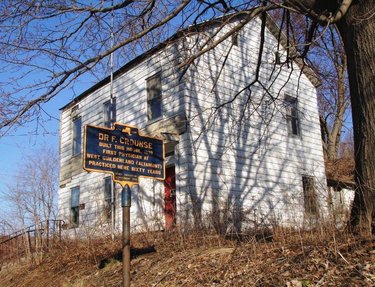Crounse House to be demolished
GUILDERLAND — A bulldozer will soon complete what time and inattention have wreaked on the historic Crounse House, just outside of Altamont on the village’s Main Street.
At its Dec. 5 meeting, the town board voted, 4 to 0, to demolish the building at 759 Route 146, at the intersection with Gun Club Road.
The building has been condemned by the town’s acting chief building and zoning inspector, Jacqueline Coons.
“The whole roof on the back of it is falling in on itself,” said Coons last week.
The Federal-era single-family home has been jointly owned for over a decade by the village and the town. The municipalities bought it, after it went into foreclosure, for $40,000 — the amount of back taxes due — with each paying $20,000.
In February, an engineer hired by the village said that, while sections in the back of the house had collapsed, the primary structure is in generally good to poor shape.
The home of Frederick Crounse, where Altamont’s first doctor lived and practiced, has sat empty for more than three decades. Injured soldiers returning from the Civil War were among those he treated. The 134 Regiment came from Schoharie and camped in front of Dr. Crounse’s house, according to the late Arthur Gregg, who was both the town and village historian. Crounse stayed up the night, helping the regiment doctor with the sick and wounded soldiers, Gregg writes.
Almost two years ago, at an Altamont Village Board meeting held to consider whether to spend the necessary funds to repair its roof, Bob Keough, a representative of the Sons of the Union Veterans of the Civil War, stood and said he brought with him a resolution passed by members of his chapter of the organization, the George L. Willard Camp 154, stating that they would like to see the building, or as much as it as possible, preserved.
Keogh said the building was one of “very few places in the North where we know Civil War events happened.” He added, “When history is destroyed, it’s gone.”
In the last few years, roof leaks have caused significant damage inside the Crounse House. The damage was already underway when the village board considered fixing the roof in late 2015 and early 2016.
Then-mayor of Altamont James Gaughan and the village trustees decided in November 2015 to re-roof the building, to prevent it from further deterioration, using money from the village’s general fund, which would be recouped through a legislative grant obtained by Assemblywoman Patricia Fahy.
The town had been promised a grant for $175,000 to help with a number of projects in Guilderland, including repairs at the town-owned historic Schoolcraft House at 2299 Western Ave.; funding for the building of a new Tawasentha Park pool house to replace the one lost to fire in June 2015; and construction of a gazebo at the McKownville Reservoir Park, said town grant writer Donald Csaposs this week; of that amount, $25,000 was earmarked for the Crounse House roof.
Gaughan had told The Enterprise in November 2015, before learning of the presence of asbestos, “I personally would not like to lose the historic house owned by Altamont’s first doctor and in which he practiced.” Gaughan said at the time that he had worked for a long time with the trustees to find ways to raise seed funds to rehabilitate the house.
Then, in January 2016, Gaughan announced that the estimated costs of re-roofing had gone up because asbestos had been discovered in the roof. The town board had gotten an estimate from the engineering firm Barton & Loguidice of almost $39,000 that would cover re-roofing, asbestos remediation, and some necessary structural stabilization but that would leave the village with a deficit of at least $13,000.
Other options before the board were to send out another request for bids on the entire project, including asbestos remediation, or to have Barton & Loguidice complete a structural engineering report on the property that would give the village board more information as it considered long-term plans. The board decided to have the report done, at a cost of $3,200.
In February, the village board discussed the report from Barton & Loguidice, which said that the structure is “in generally good to poor shape,” according to board meeting minutes. “There are some sections in the back of the house that have collapsed, that the engineers couldn’t get to, and that are in poor shape,” the report stated.
Gaughan said at that meeting that he’d received word from Kristen Casey, acting on behalf of a citizens’ group that had interest in preserving the property. Casey said this week that she gave up on the project when she was told the costs.
The company gave two alternatives: Demolish the collapsed structures and reinforce the primary residence, which would cost approximately $53,000, or do all of that and also rebuild the kitchen structure in back, for about $112,000.
Both of those options would include the cost of asbestos remediation, but would not include interior renovations, finishes to walls or floors, improvements to plumbing, or electrical and mechanical systems.
Kerry Dineen, who was a village board trustee at the time and is now Altamont’s mayor, said at the February meeting that both of those amounts were too much to invest in a house that has been talked about not being historic.
Trustee Nicholas Fahrenkopf agreed, saying he looked forward to seeing plans or ideas from the town of Guilderland for potential use of the land that would memorialize Dr. Crounse in some way.
Gaughan said that it was more important to concentrate on preserving Dr. Crounse’s legacy than to go to great lengths to save a building that is in such bad shape.
The supervisor of Guilderland and mayor of Altamont both retired. In Guilderland, Peter Barber replaced Kenneth Runion, and in Altamont, Dineen has become mayor.
Barber said Friday that it was his understanding the property had been purchased at the request of the village, while knowing that its poor condition might not warrant a restoration or might be better used for a gateway park or other public use.
At the time of the purchase, Runion told The Enterprise the municipalities intended to use the property for community functions — youth or senior programs, for example — or as an information center for town and village residents.
After the purchase years ago, Barber said, the village took the lead in caring for the house, exploring options, and assessing the house’s structural condition. The town also secured a grant for roof work, he said, with the understanding that this work would only be undertaken if the building’s preservation was warranted.
Barber added that the town’s former historian, Alice Begley, also since retired, told him that the home’s interior had been gutted by prior owners years ago and that, other than the fact that an important person had lived in the house, the house had no historic features or artifacts.
“That’s unlike the Schoolcraft House, Frederick House, and Cobblestone Schoolhouse,” Barber said.
Barber also said that he will have the new town historian, Ann Wemple, visit the property with acting chief building and zoning inspector Jacqueline Coons to see what elements, if any, can be salvaged.
Barber said he thought a major reason for buying the building was to keep it from being sold for commercial use, and that village officials had always hoped to devote it to some kind of public, municipal use — perhaps a pocket park — in keeping with the area. There are several other historic properties nearby, Barber said.
The Knower House and the Inn of Jacob Crounse are the next properties along Route 146; they, like the Crounse House, have historic markers.
All of those structures are part of the original settlement in the area that predated the nearby village of Altamont, which grew up because of the railroad.
Gaughan declined to comment last week, referring The Enterprise to Dineen, who said in an email only that she and Barber had discussed “the path forward to demolition” and called the town board’s action Tuesday night “the first step in that process.”
At the town board meeting this week, Barber said that Highway Superintendent Steve Oliver has indicated that he and his crew can complete the work of both demolition and asbestos removal.
Csaposs has since received approval from the New York State Dormitory Authority to repurpose the $25,000, applying it to other projects that are included within the $175,000 total grant funding, he said this week.
Features that once graced the interior — such as a Federal mantlepiece and original windows — are now largely gone, taken out either during multiple rehabs done over the years or by vandals. One of the only original features left is the front entrance, where sidelights and molding surround a handcrafted door on which a “Condemned” sign now hangs.
Assemblywoman Fahy said this week that the money set aside for the roof was “definitely redirected once it was determined that saving the roof alone was not going to save the building.” The funding was initially given so that analysis could be done. “It is unfortunate,” she said, but she accepted the finding that the building, in its current state, did not have enough historic significance. She called the decision by the village and town prudent.
“I’m always motivated, and I’m still quite concerned about will happen with the Cobblestone Schoolhouse. That one I think is particularly noteworthy, because there are so few historic schoolhouses around,” Fahy added.
One of the things that most upsets Fahy with the Republicans’ federal tax plan, she said, is that, if it goes through, it will eliminate the historic preservation tax credit. This would mean, she said, that developers looking to refurbish or revitalize certain historic properties would no longer have that incentive.
At Tuesday’s town board meeting, the only resident who spoke was retired real-estate appraiser John Haluska, who noted that a historic marker stands on the property, and asked that any demolition crews be careful to keep the marker. Barber said he could guarantee it.
Updated on Dec. 6, 2017: Information on the Dec. 5 Guilderland Town Board meeting was added, as was information from the February village board meeting.



